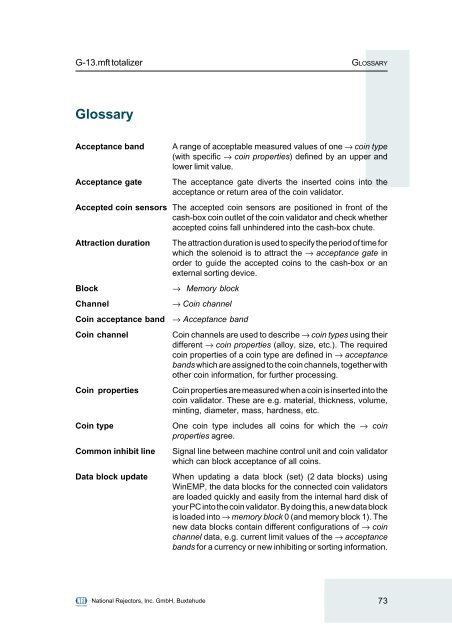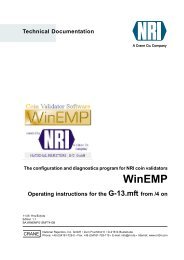G-13.mft parallel - NRI
G-13.mft parallel - NRI
G-13.mft parallel - NRI
Create successful ePaper yourself
Turn your PDF publications into a flip-book with our unique Google optimized e-Paper software.
G-<strong>13.mft</strong> totalizer GLOSSARY<br />
Glossary<br />
Acceptance band A range of acceptable measured values of one → coin type<br />
(with specific → coin properties) defined by an upper and<br />
lower limit value.<br />
Acceptance gate The acceptance gate diverts the inserted coins into the<br />
acceptance or return area of the coin validator.<br />
Accepted coin sensors The accepted coin sensors are positioned in front of the<br />
cash-box coin outlet of the coin validator and check whether<br />
accepted coins fall unhindered into the cash-box chute.<br />
Attraction duration The attraction duration is used to specify the period of time for<br />
which the solenoid is to attract the → acceptance gate in<br />
order to guide the accepted coins to the cash-box or an<br />
external sorting device.<br />
Block → Memory block<br />
Channel → Coin channel<br />
Coin acceptance band → Acceptance band<br />
Coin channel Coin channels are used to describe → coin types using their<br />
different → coin properties (alloy, size, etc.). The required<br />
coin properties of a coin type are defined in → acceptance<br />
bands which are assigned to the coin channels, together with<br />
other coin information, for further processing.<br />
Coin properties Coin properties are measured when a coin is inserted into the<br />
coin validator. These are e.g. material, thickness, volume,<br />
minting, diameter, mass, hardness, etc.<br />
Coin type One coin type includes all coins for which the → coin<br />
properties agree.<br />
Common inhibit line Signal line between machine control unit and coin validator<br />
which can block acceptance of all coins.<br />
Data block update When updating a data block (set) (2 data blocks) using<br />
WinEMP, the data blocks for the connected coin validators<br />
are loaded quickly and easily from the internal hard disk of<br />
your PC into the coin validator. By doing this, a new data block<br />
is loaded into → memory block 0 (and memory block 1). The<br />
new data blocks contain different configurations of → coin<br />
channel data, e.g. current limit values of the → acceptance<br />
bands for a currency or new inhibiting or sorting information.<br />
National Rejectors, Inc. GmbH, Buxtehude<br />
73
















